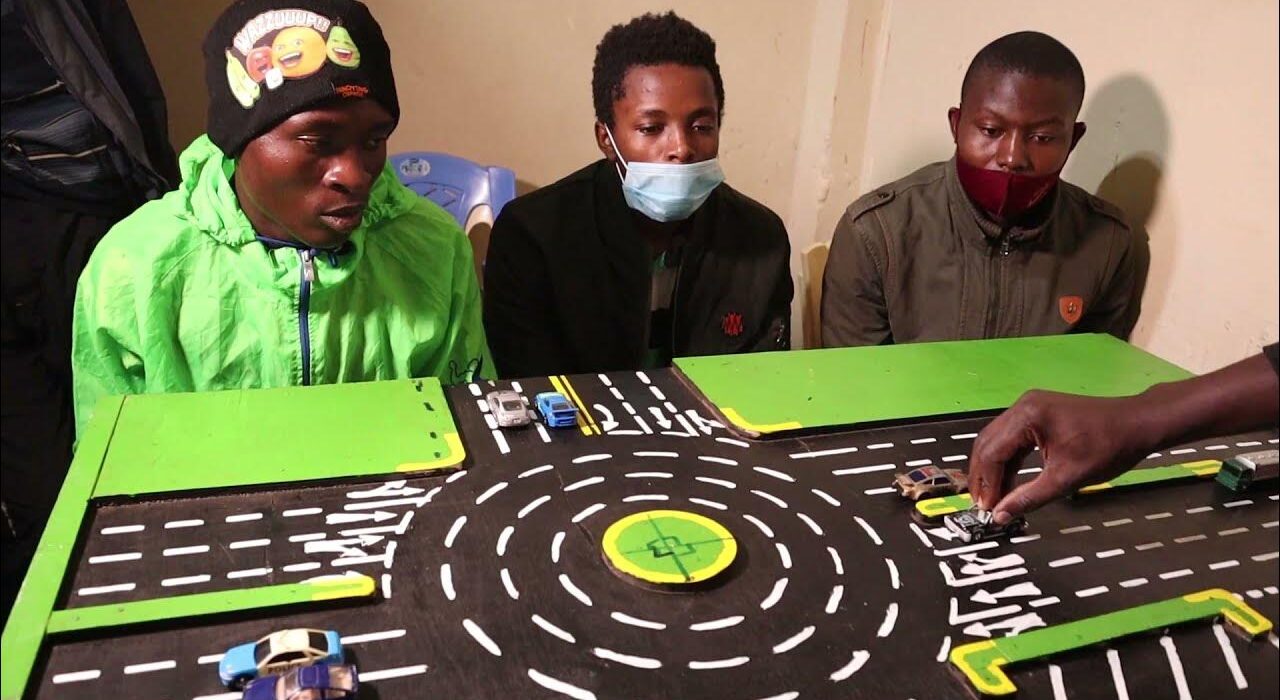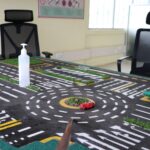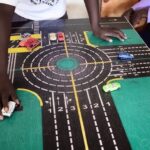Navigating Kenya’s roads requires skill, patience, and a deep understanding of traffic rules, especially when it comes to roundabouts. For learner drivers preparing for the National Transport and Safety Authority (NTSA) driving test, mastering the Model Town Board is a critical step toward earning a driver’s license. The Model Town Board, a scaled-down representation of Kenya’s road networks, is a cornerstone of driver training, helping students visualize and practice traffic rules, including those for roundabouts.
What is the Model Town Board?
The Model Town Board is a teaching tool used in Kenyan driving schools to simulate real-world road networks. Designed to mirror the complexities of urban and rural roads, it includes features like one-way and two-way traffic roads, pedestrian crossings, parking zones, and, crucially, roundabouts. The board helps learners grasp concepts such as lane discipline, road signs, and traffic flow before they hit the actual roads. For NTSA driving exams, the Model Town Board tests a candidate’s ability to apply theoretical knowledge practically, with roundabouts being a key focus due to their prevalence in Kenyan towns.
Why Roundabouts Matter
Roundabouts are circular intersections designed to manage traffic flow without the need for traffic lights, promoting smoother and safer movement. In Kenya, roundabouts are common in urban centers like Nairobi, Mombasa, and Kisumu, but they can be challenging for new drivers. Misunderstanding roundabout rules often leads to confusion, delays, or accidents. The Model Town Board simplifies this by allowing learners to practice in a controlled environment, ensuring they understand how to approach, navigate, and exit roundabouts correctly.
Key Features of Roundabouts on the Model Town Board
The Model Town Board includes several elements that replicate real-world roundabouts These features help learners understand the structure and rules of roundabouts:
- Central Island: The core of the roundabout, around which vehicles move in a clockwise direction.
- Lanes: Multiple lanes (typically two or three) for entering, circulating, and exiting the roundabout.
- Road Markings: Arrows, broken lines, and continuous lines guide lane discipline and movement.
- Signs: Stop signs, give-way (yield) signs, and directional signs regulate traffic flow.
- Entry and Exit Points: Points where vehicles join or leave the roundabout, often marked with give-way signs.
These components simulate real-life scenarios, preparing learners for the complexities of Kenyan roads.
Rules for Navigating Roundabouts on the Model Town Board
The NTSA emphasizes specific rules for navigating roundabouts, both on the Model Town Board and in real-world driving. Below is a breakdown of the key regulations:
1. Approach the Roundabout in the Correct Lane
Lane discipline is critical when approaching a roundabout. The Model Town Board tests learners on their ability to choose the appropriate lane based on their intended direction:
- Left Turn (90°): Use the leftmost lane (Lane 1) on a three- or four-lane road.
- Straight Ahead (0°): Use the middle lane (Lane 2) or left lane, depending on the board’s configuration.
- Right Turn (90° or 180°): Use the rightmost lane (Lane 3 or 4) and signal early to indicate your intent.
- Full Circle (360°): Use the rightmost lane to complete a full loop around the roundabout.
Example Question: On a three-lane road approaching a roundabout, which lane should you use to go straight?
Answer: Lane 2, as it is designated for straight-ahead movement.
2. Yield to Traffic Already in the Roundabout
One of the golden rules of roundabouts in Kenya is to give way to vehicles already circulating. This is emphasized in NTSA guidelines, which note that traffic flows counterclockwise, and entering vehicles must yield to those in the roundabout. On the Model Town Board, learners must:
- Slow down or stop at the give-way sign.
- Check for oncoming traffic from the right (since Kenya drives on the left).
- Enter only when the roundabout is clear and safe.
Example Question: What should you do when approaching a roundabout with a give-way sign?
Answer: Slow down, yield to traffic from the right, and enter when safe.
3. Maintain Lane Discipline
Changing lanes within a roundabout is strictly prohibited, as highlighted in NTSA guidelines. On the Model Town Board, learners are tested on their ability to stay in their chosen lane throughout the roundabout. Common mistakes include:
- Switching lanes to exit prematurely.
- Straddling lanes, which confuses other drivers.
- Failing to signal when exiting.
Tip: Always signal your exit to alert other drivers, and maintain your lane until you reach your exit point.
4. No Stopping or Parking
Roundabouts are designed for continuous traffic flow, so stopping or parking inside them is not allowed. The Model Town Board reinforces this rule. Learners must keep moving unless yielding at an entry point.
5. Use the Shortest or Correct Route
NTSA’s Model Town Board rules prioritize efficiency. Learners must:
- Use the shortest and most correct route without entering parking zones unless instructed.
- Use the longest correct route if specified by the examiner.
- Resort to parking zones only as a last option.
This rule tests a driver’s ability to plan their route while adhering to traffic regulations.
6. Observe Traffic Signs and Signals
Roundabouts on the Model Town Board feature signs like stop signs, give-way signs, and road markings. Learners must:
- Stop fully at a stop sign and check both directions before proceeding.
- Slow down or stop at a give-way sign if traffic is approaching from the right.
- Follow road markings, such as arrows indicating permissible directions.
Example Question: What does a red triangular give-way sign mean at a roundabout?
Answer: Slow down or stop to yield to traffic from other directions, proceeding only when safe.
Common Mistakes to Avoid on the Model Town Board
Even experienced learners can falter on the Model Town Board, especially with roundabouts. Business Radar lists common errors that lead to exam failures:
- Wrong Lane Choices: Entering the roundabout in the incorrect lane for the intended direction.
- Ignoring Give-Way Rules: Failing to yield to circulating traffic, causing potential collisions.
- Improper Signaling: Not indicating when entering or exiting, leading to confusion.
- Lane Changes in the Roundabout: Switching lanes mid-roundabout, which is prohibited.
- Misinterpreting Signs: Ignoring stop or give-way signs, leading to unsafe maneuvers.
To avoid these pitfalls, learners should practice extensively on the Model Town Board and study the Highway Code, which provides detailed guidance on roundabout navigation.
Real-World Application: Roundabout Rules in Kenya
The skills learned on the Model Town Board translate directly to real-world driving. Kenya’s roundabouts, such as those on Thika Road or Ngong Road in Nairobi, follow the same principles tested in the NTSA exam. Key real-world roundabout rules include:
- Yield to Traffic from the Right: Always give way to vehicles already in the roundabout.
- Signal Intentions: Indicate left for left turns, right for right turns, or no signal for going straight until exiting.
- Maintain Speed: Enter at a controlled speed (typically below 30 km/h) to ensure safety.
- Avoid Overtaking: Overtaking within a roundabout is dangerous and prohibited.
These rules align with the Model Town Board’s teachings, ensuring learners are prepared for Kenya’s busy roads.
Tips for Mastering Roundabouts on the Model Town Board
To excel in the NTSA driving exam and navigate roundabouts confidently, consider these practical tips:
- Study the Highway Code: Familiarize yourself with road signs, signals, and rules specific to roundabouts.
- Practice with a Toy Car: Use the Model Town Board to simulate scenarios, moving a toy car to practice lane discipline and route planning.
- Memorize Lane Rules: Know which lane to use for each direction (e.g., Lane 1 for left turns, Lane 3 for right turns).
- Understand Priorities: Always yield to traffic from the right and avoid entering if the roundabout is busy.
- Take Mock Tests: Practice NTSA-style questions, such as those provided by ntsanews.co.ke, to build confidence.
- Learn from Mistakes: Review common errors and practice correcting them during driving school sessions.
Frequently Asked Questions
Here are some common NTSA Model Town Board questions related to roundabouts:
- What is the most important rule for roundabouts on the Model Town Board?
Answer: Always give way to vehicles coming from the right side in the roundabout. - Which lane should you use to turn right on a four-lane roundabout?
Answer: Use Lane 3 or 4, depending on the board’s configuration, and signal right. - Can you change lanes inside a roundabout?
Answer: No, changing lanes within a roundabout is prohibited to ensure safety. - What should you do if you miss your exit on a roundabout?
Answer: Continue circling in the correct lane until you reach your exit again, signaling appropriately.
Mastering roundabout rules on the Model Town Board is essential for passing the NTSA driving test and becoming a safe driver in Kenya. By understanding lane discipline, yielding to circulating traffic, and adhering to traffic signs, learners can navigate roundabouts with confidence. The Model Town Board serves as a vital bridge between theoretical knowledge and real-world application, preparing drivers for Kenya’s dynamic road networks. As the government pushes for stricter traffic regulations in 2025, staying informed and practicing diligently will ensure aspiring drivers not only pass their exams but also contribute to safer roads. Enroll in a certified driving school, study the Highway Code, and practice on the Model Town Board to take your first step toward becoming a skilled, road-wise driver in Kenya.





